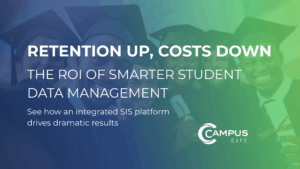
With APIs, your student information system can share and retrieve data with other systems and applications. Integrated, cloud-based student information systems are typically designed to work with API integrations. This gives institutions the flexibility to use preferred software applications, like Quickbooks for the accounting or finance department, and learning management systems.
But APIs are not always necessary. In fact, schools should look for a student information system that offers most of the features and functions it needs to eliminate – or at least reduce – the need for multiple SIS integrations.
So what APIs does your school really need – or does it need any at all? To help sort out the landscape, we dig into the pros and cons of using third-party integrations with your student information system.
In this post, we will cover:
What does an API do?

The most complex APIs share data in real-time, sending information back and forth. But APIs can vary greatly with regard to the speed of data transmission, the amount of data that is shared, and if that data is flowing just one way or back and forth between systems.
While a two-way, real-time API sounds like an ideal solution, they are not often deployed. They require a lot of IT resources and effort to keep in constant sync. So, when it comes to APIs, there’s always a sacrifice.
Pros and Cons of Using APIs
Many student information systems can accommodate most of the functions and activities that your school would need from another platform or provider, so just because you can use APIs, it doesn’t mean you should.
Take stock of these pros and cons to determine what third-party software your school needs and how APIs might enhance – or detract from – your student information system.
Pros
1. APIs Can Complement Your SIS
For certain modules and functions, an API enhances SIS functionality and improves performance. For instance, it can be beneficial to use an API to connect to a payment system or email relays, including Google and Microsoft, where APIs share a limited amount of data and have a very specific function.
2. Allows You to Integrate Best-of-Breed Software
At most schools, departments and users have preferred software providers for specific functions, such as Slate for admissions or Raiser’s Edge for fundraising.
An API lets your school to continue using your favorite applications and software and integrate the data in real-time with your preferred student information software.
At Campus Cafe Software, we understand that our clients have their preferences, and our system can accommodate many of those third-party applications.
3. Get Real-Time Updates and Information
With an API, information flows continually between your student information system and third-party applications. This means that users will always have access to the most updated information and data, so all stakeholders are working from a single source of truth.
Schools need to determine whether the API is operating in real-time and shares data both ways, as well as what type of data is being shared.
Cons
1. May Create a Data Vacuum Between Departments
Whenever you have departments working on two different software systems, there’s a risk that data won’t be properly transmitted or there could be a lag.
When information is missing or incomplete, mistakes happen and opportunities are lost. If the marketing team uses a third-party app to register and record their leads, but that information isn’t transferred to the student information system, those prospects could fall through the cracks.
If admissions and financial aid – or the registrar’s office and finance – don’t have the data they need or it’s not being transmitted completely, they wont’ be able to properly do their jobs and students’ coursework and aid could be at risk.
2. Reporting and Usage Roadblocks
The best-case scenario is all departments having equal access to real-time information within a single system, which allows for closed-loop reporting. But if you have an API or multiple APIs connected to your student information system, there could be gaps or lags that prevent this.
The result is that teams have to resort to manual data entry and time-consuming data matching. This can be a serious impediment to compiling government-required or internal reports that rely on data from multiple sources, such as IPEDS.
Examples of this include the registrar’s office or financial aid office being unable to generate internal or external reports due to missing or incomplete information, which can lead to missing federal reporting deadlines and potentially delaying financial aid.
Also, you’ll need to train your team on how to use another software platform, which makes the implementation process more complex.
3. Security Concerns
Like any software or computer system, an API can be vulnerable to cyber-attacks. Reputable vendors will deploy the latest security features and monitor their systems, but there’s always the chance that hackers can access your school’s records and student information.
Minimizing the use of third-party APIs helps reduce the risk of security breaches.
How Higher-Ed Departments and Staff Use APIs
Across campus, your departments may have specific needs or requests that justify using an API. Below are some of the most common uses.
Admissions
An API can help manage the admissions funnel by connecting the data dots between marketing, recruiting and admissions. However, third-party software can’t handle the entire process.
For admissions, there are two common scenarios in which schools use third-party software that requires an API:
- Importing leads or contact information from forms or a mass email service into the SIS.
- Connecting to a best-of-breed admissions software that manages the entire process (this could result in incomplete data transfer).
Campus Cafe Software’s integrated student information system can be used for marketing, recruiting and application management. However, some schools prefer to use an API for marketing to plan, manage and execute marketing campaigns. In that instance, we recommend using an API for marketing, which is first part of the admissions funnel, and then using Campus Cafe to manage prospects during recruiting and application management.
Alternatively, our clients can use Campus Cafe to manage all three stages of the admissions process. This is the most streamlined way to manage the admissions lifecycle for closed-loop reporting.
Finance and Billing
Higher-education institutions are big businesses with bills to pay, payroll to manage and payments to collect from students. In some instances, an API can help the business office manage these operations.
For instance, third-party software may be necessary for students to make electronic payments, or to export billing and payment data to popular outside accounting software such as Quickbooks, Microsoft Dynamics or Sage.
Professors, Faculty and Instructors
Learning management systems (LMS) are by far the most common API to integrate with a student information system. Faculty and instructors can create and share lesson plans, manage assignments and coursework, and administer tests. An LMS also allows schools to administer in-person and remote learning, which has become particularly important in the last several years.
Some of the most widely used LMSs include Moodle, Canvas, Blackboard and Schoology. Campus Cafe can connect to these and more via real-time restful API or batch process for course registrations, lessons, assignments, exams and grades.
Attendance
At many schools, faculty take attendance and submit the information manually or electronically. In some instances, instructors may even still take attendance on paper rosters.
Today, many schools are moving to third-party attendance software, which registers attendance by geo-locating student’s devices or having them sign in electronically when they attend a class remotely or in-person. An attendance API seamlessly verifies attendance and transmits that information to your SIS. The result is more timely and accurate data. It also frees up faculty to focus on instruction and student relationships. The registrar’s office and school staff can also monitor attendance to look for at-risk students who do not regularly attend class.
Common API Integrations for Higher Education
An API can help satisfy a particular operational need or provide a specialized function. For that reason, it’s important that a student information system is capable of integrating APIs.
Campus Cafe Software’s system can handle almost any school’s needs without the addition of APIs beyond an LMS, but we understand there are some APIs that your school will want to use. Below are the most common requests we receive for third-party APIs.
- Marketing software: Our built-in CRM works with your school’s internal email system and can integrate with third-party apps, such as Constant Contact, Hubspot, Mailchimp, qualtrics, Zapier and Zoho, for larger email campaigns. The API also brings leads back into the Campus Cafe system for your admissions team to track and follow.
- Learning Management Systems: Via a batch relay or REST API, Campus Cafe integrates with the most popular LMSs, including Moodle, Canvas, Blackboard, Google Apps for Education and Schoology.
- Email and communications: To seamlessly support third-party communications apps, Campus Cafe integrates with email platforms, including Google’s Gmail, and cloud-based software for email, phone and texting, such as RingCentral.
- Document signature: To simplify document management, schools can add an electronic signature API, such as Docusign.
- Billing and payments: Business and accounting teams rely on third-party integrations, such as Stripe, Quickbooks, BankMobile, Great Plains, Microsoft, to manage accounts and payments.
- Attendance: Electronic and geo-based attendance apps like CourseKey simplify and streamline attendance management.
The Bottom Line on APIs: Less is More
With an integrated student information, many of the functions you need are baked right into the SIS. The best student management software requires minimal APIs. Your team doesn’t have to learn a new system or worry about information reliably transferring between systems.
We understand our clients have their software preferences and we can connect the tools and software you need via customized or open API integrations. This allows your school to share information between Campus Cafe’s SIS and your chosen learning management systems, finance and billing apps, marketing tools or accounting software. Maybe you really can have it all.
Contact us today to see how Campus Cafe can transform your school’s operations and accommodate your favorite APIs.




